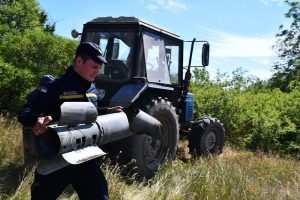
Introduction
The conflict in Ukraine raises questions about the impact of depleted uranium (DU) weaponry on agriculture. Understanding the effects of DU contamination on soil, plant growth, and groundwater is crucial for both Ukraine and world food security. This article reviews scientific studies on uranium accumulation in crops and explores the significant impacts surrounding the (assumed) use of DU weapons in the region. The findings are also linked to other conflict zones, like Iraq or Serbia, where the use of DU weapons has resulted in similar environmental and agricultural problems. One major obstacle is that users and officials do not provide data on the locations where DU weapons have been used, or where contaminated remnants of war are located, stored, or dumped. This lack of transparency poses a severe threat to all living creatures, to the food chain, groundwater, as well as impeding warning protection matters.
Moreover, it is important to place this issue in a broader context: DU is just one of many pollutants present during war and armed conflicts. Many other toxic residues and remnants endanger the environment, the climate, and human beings. The connection between the scientific findings and the issues related to war and weaponry is clear: the use of DU weapons results in soil and groundwater contamination, which subsequently has harmful effects on agriculture. High levels of uranium in the soil, stemming from DU weaponry, result in decreased crop yields and inhibited plant growth. This contamination also poses significant long-term risks to ecosystems and food chains, exacerbating environmental degradation in war torn zones.
The deployment of DU weapons in Ukraine has raised profound political alarm. The decision to introduce such weaponry into the war area has sparked international debate and deepened concerns about the potential ramifications. The urgency of addressing these geopolitical chal- lenges alongside the environmental and agricultural impacts underscores the pressing need for concerted global action to mitigate the devastating consequences of DU warfare, finally prevent it.
Current Use of Depleted Uranium in Ukraine
On September 7, 2023, the US announced it would send ”controversial” weapons to Ukraine, including 120mm depleted uranium (DU) tank rounds for M1 Abrams tanks as part of over $1 billion in military and humanitarian aid. This decision marks a significant policy shift from March when the Pentagon stated it would not send DU munitions to Ukraine. The assumed use of DU weaponry has sparked considerable debate.
Russia condemned the move and the use of DU weaponry without mentioning its possible own DU usage, a sentiment echoed by Maria Sacharowa’s post. The UN Environment Programme (UNEP) has expressed apprehensions about potential health issues arising from DU use in Ukraine, noting that chemical toxicity could pose more significant risks than radioactivity. ICBUW strongly criticizes the use of DU weaponry and advocates for close monitoring of the situation, emphasizing the importance of scrutiny and a total ban on DU weapon use.
The Impact of DU Weapons on Agriculture and Environment
Scientific research provides critical insights into how uranium affects agriculture. For example, Mordberg et al. found that high 238U levels in soil reduce crop yields by inhibiting corn growth and decreasing overall yields due to the toxicity of the radionuclide to root systems. Similarly, barley grown on contaminated soil exhibited a notable decline in biomass and grain production, underscoring the harmful impact of uranium on crop health. Plants accumulate uranium at different rates throughout their growth stages, with oats and barley showing the highest levels of accumulation. Kasianenko et al. further explored the movement of uranium in soil and plants, revealing that increased uranium levels in the soil negatively affect plant growth, resulting in smaller crops and cellular damage.
The chemical toxicity of DU is particularly concerning. Asic et al. highlight that DU particles, once introduced into the environment, can persist for long periods, contaminating soil and water, which are essential for agriculture. This prolonged contamination can lead to higher uranium absorption by plants and animals, disrupting food chains and harming biodiversity. DU’s dual nature as both chemically toxic and radioactive poses long-term risks to ecosystems.
The situation in Ukraine mirrors the environmental and agricultural impacts seen in other con- flict zones where DU weapons have been used. For instance, studies by Razaq et al. in Iraq reveal severe soil contamination, reduced agricultural productivity, and long-term health issues among local populations. Sahoo et al. also discovered similar contamination on southern Serbian soil after the NATO operation. These parallels illustrate the widespread and enduring nature of DU contamination in war-torn areas, emphasizing the need for international attention, action and the worldwide ban on DU weapons.
Conclusion
The possible use of DU weapons in Ukraine has detrimental effects on the environment and food security. Research shows that uranium contamination harms soil and plants, leading to reduced agricultural productivity. These findings underscore the need for greater environmental protection efforts in war zones. Additionally, the intersection of environmental and political factors in areas like Iraq exemplifies the broader implications of DU contamination, social and psychological factors may be added as people in these areas simply fear to restart agriculture because of ”DU rumors”. International collaboration and strong policies are essential to address these issues effectively. In conclusion, it is imperative to highlight the negative potential of DU weapon use, especially considering the absence of effective remediation measures, which underscores the urgent need for heightened awareness and action regarding the consequences of DU weaponry deployment.
ICBUW – Intern, 08.06.2024
This article as a download (with references): File

